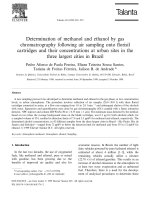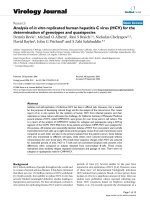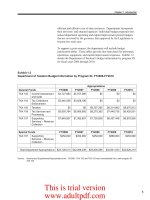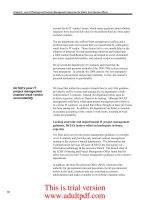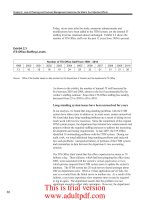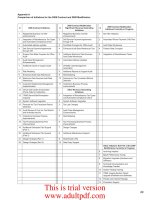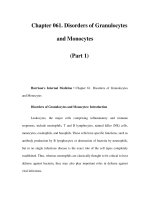Chapter 05 determination of forward and futures prices
Bạn đang xem bản rút gọn của tài liệu. Xem và tải ngay bản đầy đủ của tài liệu tại đây (652.16 KB, 25 trang )
Chapter 5
Determination of Forward and
Futures Prices
Options, Futures, and Other Derivatives, 8th Edition,
Copyright © John C. Hull 2012 1
Consumption vs Investment Assets
Investment assets are assets held by
significant numbers of people purely for
investment purposes (Examples: gold,
silver)
Consumption assets are assets held
primarily for consumption (Examples:
copper, oil)
Options, Futures, and Other Derivatives, 8th Edition,
Copyright © John C. Hull 2012
2
Short Selling (Page 102-103)
Short selling involves selling securities
you do not own
Your broker borrows the securities
from another client and sells them in
the market in the usual way
Options, Futures, and Other Derivatives, 8th Edition,
Copyright © John C. Hull 2012
3
Short Selling (continued)
At some stage you must buy the
securities so they can be replaced in the
account of the client
You must pay dividends and other
benefits the owner of the securities
receives
There may be a small fee for borrowing
the securities
Options, Futures, and Other Derivatives, 8th Edition,
Copyright © John C. Hull 2012
4
Example
You short 100 shares when the price is $100
and close out the short position three months
later when the price is $90
During the three months a dividend of $3 per
share is paid
What is your profit?
What would be your loss if you had bought
100 shares?
Options, Futures, and Other Derivatives, 8th Edition,
Copyright © John C. Hull 2012
5
Notation for Valuing Futures and
Forward Contracts
Options, Futures, and Other Derivatives, 8th Edition,
Copyright © John C. Hull 2012
6
S
0
: Spot price today
F
0
: Futures or forward price today
T: Time until delivery date
r: Risk-free interest rate for
maturity T
An Arbitrage Opportunity?
Suppose that:
The spot price of a non-dividend-paying stock
is $40
The 3-month forward price is $43
The 3-month US$ interest rate is 5% per
annum
Is there an arbitrage opportunity?
Options, Futures, and Other Derivatives, 8th Edition,
Copyright © John C. Hull 2012
7
Another Arbitrage Opportunity?
Suppose that:
The spot price of nondividend-paying stock
is $40
The 3-month forward price is US$39
The 1-year US$ interest rate is 5% per
annum
Is there an arbitrage opportunity?
Options, Futures, and Other Derivatives, 8th Edition,
Copyright © John C. Hull 2012
8
The Forward Price
If the spot price of an investment asset is S
0
and
the futures price for a contract deliverable in T
years is F
0
, then
F
0
= S
0
e
rT
where r is the T-year risk-free rate of interest.
In our examples, S
0
=40, T=0.25, and r=0.05 so
that
F
0
= 40e
0.05×0.25
= 40.50
Options, Futures, and Other Derivatives, 8th Edition,
Copyright © John C. Hull 2012
9
If Short Sales Are Not Possible
Formula still works for an investment asset
because investors who hold the asset will sell
it and buy forward contracts when the forward
price is too low
Options, Futures, and Other Derivatives, 8th Edition,
Copyright © John C. Hull 2012
10
When an Investment Asset
Provides a Known Income (page 107,
equation 5.2)
F
0
= (S
0
– I )e
rT
where I is the present value of the income
during life of forward contract
Options, Futures, and Other Derivatives, 8th Edition,
Copyright © John C. Hull 2012
11
When an Investment Asset Provides
a Known Yield (Page 109, equation 5.3)
F
0
= S
0
e
(r–q )T
where q is the average yield during the life
of the contract (expressed with continuous
compounding)
Options, Futures, and Other Derivatives, 8th Edition,
Copyright © John C. Hull 2012
12
Valuing a Forward Contract
A forward contract is worth zero (except for
bid-offer spread effects) when it is first
negotiated
Later it may have a positive or negative value
Suppose that K is the delivery price and F
0
is
the forward price for a contract that would be
negotiated today
Options, Futures, and Other Derivatives, 8th Edition,
Copyright © John C. Hull 2012
13
Valuing a Forward Contract
Page 109-11
By considering the difference between a
contract with delivery price K and a contract
with delivery price F
0
we can deduce that:
the value of a long forward contract, ƒ, is
(F
0
– K )e
–rT
the value of a short forward contract is
(K – F
0
)e
–rT
Options, Futures, and Other Derivatives, 8th Edition,
Copyright © John C. Hull 2012
14
Forward vs Futures Prices
When the maturity and asset price are the same, forward
and futures prices are usually assumed to be equal.
(Eurodollar futures are an exception)
When interest rates are uncertain they are, in theory,
slightly different:
A strong positive correlation between interest rates and the asset
price implies the futures price is slightly higher than the forward
price
A strong negative correlation implies the reverse
Options, Futures, and Other Derivatives, 8th Edition,
Copyright © John C. Hull 2012
15
Stock Index (Page 112-114)
Can be viewed as an investment asset
paying a dividend yield
The futures price and spot price relationship
is therefore
F
0
= S
0
e
(r–q )T
where q is the average dividend yield on the
portfolio represented by the index during life
of contract
Options, Futures, and Other Derivatives, 8th Edition,
Copyright © John C. Hull 2012
16
Stock Index (continued)
For the formula to be true it is important that
the index represent an investment asset
In other words, changes in the index must
correspond to changes in the value of a
tradable portfolio
The Nikkei index viewed as a dollar number
does not represent an investment asset (See
Business Snapshot 5.3, page 113)
Options, Futures, and Other Derivatives, 8th Edition,
Copyright © John C. Hull 2012
17
Index Arbitrage
When F
0
> S
0
e
(r-q)T
an arbitrageur buys the stocks
underlying the index and sells futures
When F
0
< S
0
e
(r-q)T
an arbitrageur buys futures
and shorts or sells the stocks underlying the
index
Options, Futures, and Other Derivatives, 8th Edition,
Copyright © John C. Hull 2012
18
Index Arbitrage
(continued)
Index arbitrage involves simultaneous trades in
futures and many different stocks
Very often a computer is used to generate the
trades
Occasionally simultaneous trades are not
possible and the theoretical no-arbitrage
relationship between F
0
and S
0
does not hold
(see Business Snapshot 5.4 on page 114)
Options, Futures, and Other Derivatives, 8th Edition,
Copyright © John C. Hull 2012
19
Futures and Forwards on
Currencies (Page 112-115)
A foreign currency is analogous to a
security providing a yield
The yield is the foreign risk-free interest
rate
It follows that if r
f
is the foreign risk-free
interest rate
Options, Futures, and Other Derivatives, 8th Edition,
Copyright © John C. Hull 2012
20
F S e
r r T
f
0 0
=
−
( )
Explanation of the Relationship
Between Spot and Forward (Figure 5.1)
Options, Futures, and Other Derivatives, 8th Edition,
Copyright © John C. Hull 2012 21
T
e
Tr
f
time at
currency foreign
of units 1000
T
eF
Tr
f
time at dollars
1000
0
Consumption Assets: Storage is
Negative Income
F
0
≤ S
0
e
(r+u )T
where u is the storage cost per unit time as a
percent of the asset value.
Alternatively,
F
0
≤
(S
0
+U )e
rT
where U is the present value of the storage
costs.
Options, Futures, and Other Derivatives, 8th Edition,
Copyright © John C. Hull 2012
22
The Cost of Carry (Page 118)
The cost of carry, c, is the storage cost plus
the interest costs less the income earned
For an investment asset F
0
= S
0
e
cT
For a consumption asset F
0
≤ S
0
e
cT
The convenience yield on the consumption
asset, y, is defined so that
F
0
= S
0
e
(c–y )T
Options, Futures, and Other Derivatives, 8th Edition,
Copyright © John C. Hull 2012
23
Futures Prices & Expected Future
Spot Prices (Page 121-123)
Suppose k is the expected return required by
investors in an asset
We can invest F
0
e
–r T
at the risk-free rate and enter into
a long futures contract to create a cash inflow of S
T
at
maturity
This shows that
Options, Futures, and Other Derivatives, 8th Edition,
Copyright © John C. Hull 2012
24
Tkr
T
T
kTrT
eSEF
SEeeF
)(
0
0
)(
or
)(
−
−
=
=
Futures Prices & Future Spot
Prices (continued)
Options, Futures, and Other Derivatives, 8th Edition,
Copyright © John C. Hull 2012 25
No Systematic Risk
k = r
F
0
= E(S
T
)
Positive Systematic Risk
k > r
F
0
< E(S
T
)
Negative Systematic Risk
k < r
F
0
> E(S
T
)
Positive systematic risk: stock indices
Negative systematic risk: gold (at least for some periods)

